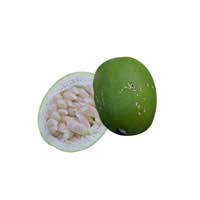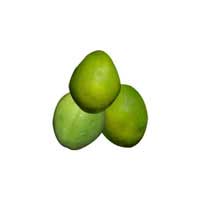 Full List of Fruits
Full List of Fruits  Maypop
MaypopMaypop Fruit
Scientific name - Passiflora incarnate
With trailing stems that are climbing, Passiflora incarnata is a fast-growing perennial trailing plant which is a member of the passion flower genus Passiflora. Known by several other indigenous names such as wild apricot, purple passion flower and wild passion vine, with high up styles, many tendrils and stamens, they hold large and intricate flowers. With that said, it is one of the hardiest species of passion flower that's quite common in the southern United States.
 Stem: Smooth, pubescent, long and sprawling
Stem: Smooth, pubescent, long and sprawling
 Leaves: they are 3 lobed and occasionally 5 lobed; 6-15 centimetres; 2.4-5.9 inches
Leaves: they are 3 lobed and occasionally 5 lobed; 6-15 centimetres; 2.4-5.9 inches
 Flowers: bluish-white petals, white and purple corona; blooms in July
Flowers: bluish-white petals, white and purple corona; blooms in July
As it matures, they become orange in color from green. Generally referred to as a maypop, the size of the fleshy fruit is of a hen egg; yellowish in color. The fruit is very popular with wildlife.
![]() Nutritional Value of Maypop Fruit
Nutritional Value of Maypop Fruit
| Nutritional value per 100 g (3.5 oz) | |
| Energy | 406 kJ (97 kcal) |
| Carbohydrates | 23.38 g |
| Sugars | 11.2 g |
| Dietary fiber | 10.4 g |
| Fat | 0.7 g |
| Protein | 2.2 g |
| Vitamins | |
| Vitamin A equiv. | (8%) 64 µg |
| beta-carotene | (7%) 743 µg |
| Riboflavin (B2) | (11%) 0.13 mg |
| Niacin (B3) | (10%) 1.5 mg |
| Vitamin B6 | (8%) 0.1 mg |
| Folate (B9) | (4%) 14 µg |
| Choline | (2%) 7.6 mg |
| Vitamin C | (36%) 30 mg |
| Vitamin K | (1%) 0.7 µg |
| Trace metals | |
| Calcium | (1%) 12 mg |
| Iron | (12%) 1.6 mg |
| Magnesium | (8%) 29 mg |
| Phosphorus | (10%) 68 mg |
| Potassium | (7%) 348 mg |
| Sodium | (2%) 28 mg |
| Zinc | (1%) 0.1 mg |
![]() Health benefits of Maypop Fruit
Health benefits of Maypop Fruit
Fresh or dried whole plant of Passiflora incarnate has been used as an herbal medicine to treat insomnia and nervous anxiety traditionally. Many clinical studies imply that it has the capacity to perk up the subjective quality of sleep when it is consumed in the form of tea.
An extract of the plant is highly sedative and helps in slightly reducing blood pressure while increasing respiratory rate. However, usage of it during pregnancy is not highly recommended. A homeopathic remedy is made from the plant and a cataplasm of the roots is applied to cuts, boils, earaches, inflammation etc. With a long history of use, they are a valuable sedative which is also considered as a tranquilizing herb in North America. In addition, they are highly helpful in the treatment of insomnia, epilepsy, hysteria etc. With regards to women's complaints, they are considered as a blessing.
Apart from the above said ailments, they are also helpful in treating:
 Nervous tension
Nervous tension
 Irritability
Irritability
 Neuralgia
Neuralgia
 Irritable bowel syndrome
Irritable bowel syndrome
 Pre-menstrual tension and
Pre-menstrual tension and
 Vaginal discharges
Vaginal discharges
From full sun to part shade, it thrives in well-drained soil that is of medium moisture. They are highly drought tolerant. They are easily grown from seed.
30-40 square feet of support is essential for this clinging vine with a frequent watering for unestablished plants. During the winter time when temperature goes below freezing, chances are that the vine dies back to the ground; as a result, they can often be grown over shrubs and trees without harm.


















